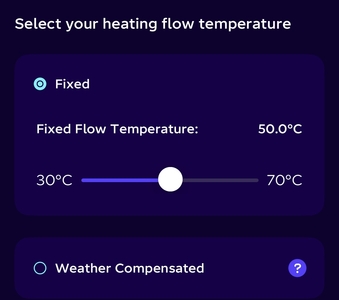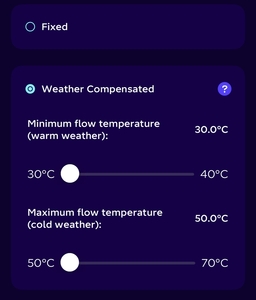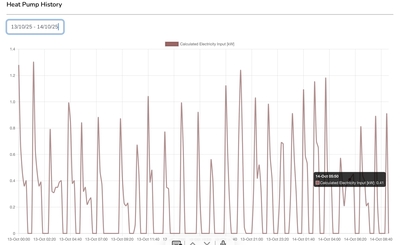Heat loss calculations and how they work in conjunction with heat pump sizing
Posted by: @jamespaThat depends on the circumstance and your assertion is not necessarily true. If for example if oversizing leads you to going from one heat pump to 2, the change is enormous. If it leads to you requiring a 2 fan pump rather than a one fan, and there is no good space for a 2 fan, then the impact is equally enormous. Likewise its an enormous impact if oversizing results in floorboards being lifted (or worse still solid flooring) to upgrade pipework unnecessarily. In general terms the difference is bigger the larger the loss.
Yes that is a very fair point. I was thinking of the situation where you really need a 10kW heat pump, but install a 12kW or 16kW. Other items could indeed be expensive for the customer - which of course also means more revenue for the installer.
On reflection your point applies to us. One installer told us we needed 2 x 10kW heat pumps, which probably implied a buffer tank and less efficiency. He also suggested that we would need to upgrade to a 3 phase power supply for the two heat pumps. That would have cost us £an additional 20k.
Grant Aerona 290 15.5kW, Grant Smart Controller, 2 x 200l cylinders, hot water plate heat exchanger, Single zone open loop system with TRVs for bedrooms & one sunny living room, Weather compensation with set back by room thermostat based load compensation
Posted by: @majordennisbloodnok@batpred, English does not seem to be your first language
I too had exactly the same thought, and agree 100% (note I did not write 110%...) with the Major, in such cases, the simpler the language the better. If you must use technical terms, define them the first time you use them, so that we are all clear what a word or a phrase means.
Midea 14kW (for now...) ASHP heating both building and DHW
@cathoderay I read your response through twice, it was very informative if a tad long 🙂
I monitor my system every day and have tweaked the settings to get as high a COP as feasible. I have weather comp on, and have adjusted the flow temps as low as the Octopus App allows
If you turn WC off, default is 50C but can set Flow Temp to 70C which is disastrous for the COP, but you could set the system up that way
I have UFH so don't want a flow temps over 40C as I have no mixer valve
My settings are in the photo above, Couldn't figure out how to move photo to here, ill be monitoring the comfort level of the house against COP through my first full winter period to see if my strategy works
I have the room stat set at 20.5 all day and night, so the HP is just ticking over at a very good COP of 4.6-5.2 this past month.
ive also set the DHW heating to midday when the HP wont have to work so hard to heat the tank
Posted by: @batpredI reported details of a case where some friends of mine had constant temperature for the house, they were focused on efficiency and had this idea that to maximise it, the pump had to be working at all times...
Then we had an installer over was also very much insisting that the system should be running continuously. For efficiency.
With a well designed system with a tolerably well insulated house that is true, or thereabouts. Not only for efficiency but also for cost. There are of course exceptions. A modest setback (or set forward if you have a cheap tarrif period) may save a little money, or it may not.
Thats not the same, however, as saying that it has to be operating at the same temperature 24x7, nor that all rooms must be at the same temperature.
Posted by: @batpredNot what I could call evidence but a pattern that I have to admit I assumed could be influenced by the way the systems were designed - but it could be things further down the pipeline
Its not related directly to design, even the most basic controls are quite flexible. But it is nevertheless excellent advice as a starting point and ignoring this is a mistake that is frequently made, unfortunately.
I am not an installer but will always advise householders, unless there is a very specific reason to the contrary, to start off operating 24*7 at constant temp (constant over time, different temps allowed between rooms), with all thermostats/TRVs set at least a couple of degrees above the target, and adjust the weather compensation curve to the lowest possible consistent with heating the house. This establishes a sound baseline which is close to the most efficient and cost effective operation in most cases. Some minor tweaks from this baseline might improve either comfort or cost a bit depending on house, occupancy and tarrif.
There are good reasons for this rooted in basic thermodynamics, but its a long topic to understand in full. Two key concepts to get over are (a) that heat pumps have different operating characteristics than boilers so much of what you have learned should be forgotten and (b) that houses continue to lose heat (initially at the same rate) even if the heating is switched off, and that heat still has to be replaced. If you want to understand it better I suggest you read around here, on the heat geek site, on protons for breakfast and elsewhere.
Posted by: @batpredI would guess that as a principle and since the system can accumulate heat in the cylinder, most customers would want the external unit running considering when their electricity is cheaper and generally whenever the external temperature is warmer but there will surely be many other other factors that in some cases may even be more important to them.
The cylinder is for DHW only, not for space heating, and will typically only be actively heated for 2-3 hours per day. Its generally well insulated so will retain heat for 48hrs or more unless drained off.
Posted by: @batpredThere are also various people posting in this forum talking about running the external unit continuously. Perhaps I misunderstood and they meant just the external unit to not run for short periods
Your understanding was correct the ASHP will normally be run continuously or for long periods. Thats how low temperature heating, whether from a boiler or heat pump, works.
4kW peak of solar PV since 2011; EV and a 1930s house which has been partially renovated to improve its efficiency. 7kW Vaillant heat pump.
Posted by: @agentgeorgeI read your response through twice, it was very informative if a tad long
Thank you. Better long and informative than short and impenetrable, in my way of thinking...
Posted by: @agentgeorgeIf you turn WC off, default is 50C but can set Flow Temp to 70C which is disastrous for the COP, but you could set the system up that way
Exactly, just because you can doesn't mean you should.
Posted by: @agentgeorgeMy settings are in the photo above
Photos - you should be able to drag and drop them onto your post while you are writing it. The right hand photo shows your weather compensation curve settings, but the manufacturer just has warm weather and cold weather as the defining points for each end of the curve. Do you know what counts as warm weather and cold weather in degrees C?
Posted by: @agentgeorgeI have the room stat set at 20.5 all day and night, so the HP is just ticking over at a very good COP of 4.6-5.2 this past month.
If that is so, and you are comfortable, then you have a well set up system!
Posted by: @agentgeorgeive also set the DHW heating to midday when the HP wont have to work so hard to heat the tank
I apply the same logic, make hay, or rather heat the hot water, when the sun is out, so to speak.
Midea 14kW (for now...) ASHP heating both building and DHW
Posted by: @jamespaThe cylinder is for DHW only, not for space heating
This is an important point which I forgot to emphasise. It is a 'heat store' but only for the DHW (have a look at piping diagrams).
Midea 14kW (for now...) ASHP heating both building and DHW
Posted by: @toodlesThere will be times when the 8 kW heat pump starts up with a surge much higher than 2 kW and also when adverse weather drags the COP down, there may well be periods where that same pump could draw far more than that 2 kW for an extended period of time. Regards, Toodles.
The max power I've recorded on my Home Power Monitor from my cosy6 is 1.56kW, at todays grid of 237.7V thats 6.56A; the HP has its own 16A mcb.
You're right there’s a startup surge, typical 6-10x running current; more when the motor is cold. There’s also a shutdown collapsing field voltage spike that needs suppressing too.
@agentgeorge Similarly, in this mild weather, our Daikin is just ticking over (even though we have temperature set for comfort at 22.5 C.). Of course the graph is only a report based on information provided by Mr. Daikin 😉 and will not display true peaks, or even necessarily be accurate in its’ reported values! The plot is for the last 32 hours approx. taken from the Homely installer app. Regards, Toodles.
Toodles, heats his home with cold draughts and cooks food with magnets.
Posted by: @cathoderayPosted by: @majordennisbloodnok@batpred, English does not seem to be your first language
I too had exactly the same thought, and agree 100% (note I did not write 110%...) with the Major, in such cases, the simpler the language the better. If you must use technical terms, define them the first time you use them, so that we are all clear what a word or a phrase means.
😂😂
I suffer from communicating in too many languages! One of the early ones was IT Infra language. I appreciate this is not common here. Also when people use heating engineer language it is not always understood. That does not really explain most of the "misunderstanding" in that exchange.
As someone deepening knowledge about another domain based on a broad scientific base, I may assume X is the norm whereas it is the exception at the moment. Like I remember going over youtube videos that include buffer tanks. And by that I mean a tank used to keep heat that is used later to warm the space. 🙂
16kWh Seplos Fogstar battery; 8kW Solis S6-EH1P8K-L-PLUS hybrid inverter; Ohme Home Pro EV charger; 100Amp head, HA lab on mini PC
Posted by: @batpredPosted by: @cathoderayPosted by: @majordennisbloodnok@batpred, English does not seem to be your first language
I too had exactly the same thought, and agree 100% (note I did not write 110%...) with the Major, in such cases, the simpler the language the better. If you must use technical terms, define them the first time you use them, so that we are all clear what a word or a phrase means.
...
I suffer from communicating in too many languages! One of the early ones was IT Infra language. I appreciate this is not common here. Also when people use heating engineer language it is not always understood. That does not really explain most of the "misunderstanding" in that exchange.
....
No, that is not what we mean. "IT Infra" is not a language; it's not even clear what you actually mean by this. If you mean "IT Infrastructure jargon", I can understand your sentence better, but that underlines that you're missing the point.
Your sentence structure and grammar, to pick just two examples, clearly tell me that whatever language you spoke in childhood it was not English. If communicating effectively in English is already a challenge for you, complicating what you're saying with technical jargon of any kind makes it immeasurably harder to actually understand what you mean. Your post just above suggests you think your English is fine and that it's just a matter of me not being familiar with IT terminology, but that unfortunately is incorrect in every sense.
I have no wish to criticise your language skills, but for effective communication you really need to move towards using much more basic English, construct simpler and shorter sentences and avoid technical terms where possible.
105 m2 bungalow in South East England
Mitsubishi Ecodan 8.5 kW air source heat pump
18 x 360W solar panels
1 x 6 kW GroWatt battery and SPH5000 inverter
1 x Myenergi Zappi
1 x VW ID3
Raised beds for home-grown veg and chickens for eggs
"Semper in excretia; sumus solum profundum variat"
Posted by: @cathoderay@batpred - I think it might help somewhat if you could set down what you want from your heat pump discussion here on the forum. As I currently understand it, these are hypothetical, insofar as you don't have plans to install a heat pump any time soon, and it is always a little difficult when discussing hyotheticals because, well, they are hypothetical. That said, establishing some heat pump basics, and generally making sure anything you do now in another context (eg batteries etc) wont conflict with any future heat pump installation is certainly sensible.
Thanks, none of us posting much on this forum are typical users. I doubt many would have embarked in these HP upgrades without having first understood the key aspects to consider. We all seem to have systems thinking and most agree that each householder will expect to look after their own interests.
My objective discussing heatpumps is just that when we will discuss ours, we will want to have an appreciation of what to balance and consider. One angle I was focusing on is the fact that much more space is required than with a combi boiler. Systems could work without a hot water tank. At the moment it would seem to me that buffer tanks could be a sensible choice for ROI.
My perspective is that, given the wide range of considerations involved in the choices for these energy systems for each house (electricity tariffs, battery, PV, heat loss, lifestyle, disruption accepted, etc), it is not fair to expect the installer to be able to advise anyone to reach some optimal choice. I am someone that believes in standardisation, but the housing stock and all these factors differ too much. So it is probably a space where at best we have relatively standard system designs that need to be customised and sized.. If we ever get close to that 600k a year, the installers will be more specialised. So are our neighbouring heat pump installers going to be able to supply it?
Posted by: @cathoderayAnd last but not least, much the same applies to DHW heating, We have to ditch the fossil fuel thinking, and instead go low with Steady Eddie, ie abandon the idea of instant hot water
Steady Eddie it will be. 😀
16kWh Seplos Fogstar battery; 8kW Solis S6-EH1P8K-L-PLUS hybrid inverter; Ohme Home Pro EV charger; 100Amp head, HA lab on mini PC
Posted by: @batpredAnd by that I mean a tank used to keep heat that is used later to warm the space.

Buffer tanks can best be thought of as part of a 'production line' for the heat, ie the heat passes through them but is not stored in them for any length of time. If you want to store in a tank for later space heating you would need a much bigger tank and different pipework. Its possible in principle but the scale of storage needed makes it difficult or impossible in practice.
The way to store energy for space heating is either in a battery or in the fabric of the house itself. In particular houses with ufh buried in slab concrete flooring over insulation can be sometimes be heated quite effectively this way. You 'batch heat' the floor when leccy is cheap, and it slowly releases over the next few hours. Essentially is the old idea of a storage radiator.
4kW peak of solar PV since 2011; EV and a 1930s house which has been partially renovated to improve its efficiency. 7kW Vaillant heat pump.
- 26 Forums
- 2,342 Topics
- 53 K Posts
- 509 Online
- 6,000 Members
Join Us!
Worth Watching
Latest Posts
-
RE: Advice on internal circulation pump noise
Three things that caused noise in my system after commi...
By RadWhisperer , 2 hours ago
-
RE: Who's your electricity provider and what's your tariff?
I've not heard anything about this, as yet. I get the ...
By Sheriff Fatman , 8 hours ago
-
Agree with @majordennisbloodnok on the setbacks. We hav...
By ChandyKris , 10 hours ago
-

RE: Heat Pump Heats the House… But It’s Not Cosy. Emitter Changes or System Tweak?
A quick Google search showed that building regulations ...
By GrahamF , 11 hours ago
-
RE: Octopus Cosy Heat Pump Owners & Discussion Thread
@agentgeorge I first heard (read) about it on FB this m...
By AndrewJ , 11 hours ago
-
RE: New Fogstar 15.5kWh upright solution
It is a matter of luck. 2ith Fogstar "instructions", to...
By Batpred , 11 hours ago
-

RE: Speedcomfort radiator fans
@deltona the way the links were added broke the page. A...
By Mars , 11 hours ago
-

RE: Setback savings - fact or fiction?
I agree! Even more so if we get an answer! But the chal...
By cathodeRay , 13 hours ago
-

RE: Refrigerant R32, is it now banned in the EU from 1st Jan 2027 for monobloc ASHPs?
This has been delayed from what I believe to be this ye...
By dgclimatecontrol , 16 hours ago
-
RE: Are We Sleepwalking Into Another Race to the Bottom?
this is why I provided current flow temperatures in the...
By ksim , 17 hours ago
-

RE: Why Millions of UK Homes Struggle With Heat Pumps
There's many homes that would be quite a disruption for...
By dgclimatecontrol , 17 hours ago
-
RE: Ecodan unable to hit legionella target temp - what's the consensus?
@rhh2348 ...maybe this option is what you want? Alter...
By benson , 17 hours ago
-

RE: Free Ecoheat Heat Pump Install
@old_scientist This does make the unit smaller as the b...
By dgclimatecontrol , 18 hours ago
-
RE: Ecodan - Legionella Operation Time and Target Temperature
@old_scientist hiya mate, did you ever get to the botto...
By 9jwr9 , 24 hours ago
-
RE: Configuring third party dongle for Ecodan local control
@majordennisbloodnok I think the HPDHD diagnosis may be...
By Sheriff Fatman , 2 days ago
-

RE: External pipework insulation
I don't think we can tell from a photo whether your exi...
By Transparent , 2 days ago
-
RE: Controlling Daikin Altherma via P1P2 and Home Assistant
@majordennisbloodnok That’s correct. I can’t find anywh...
By weoleyric , 2 days ago
-

RE: A Smarter Smart Controller from Homely?
@papahuhu I hope you get a swift resolution. Regards, T...
By Toodles , 3 days ago







